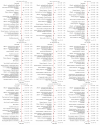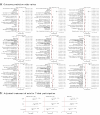This is a preprint.
Effectiveness of the Ticket to Work program in supporting employment among adults with disabilities
- PMID: 40313312
- PMCID: PMC12045388
- DOI: 10.1101/2025.04.22.25325884
Effectiveness of the Ticket to Work program in supporting employment among adults with disabilities
Abstract
Background: Returning to work benefits many people with disabilities, as it supports personal financial independence and provides opportunities for greater societal contributions. The U.S. Social Security Administration's Ticket to Work (TTW) program offers expanded support services to help disability beneficiaries achieve financial independence through gainful employment. SSA has continuously sought new ways to identify those who would most benefit from using a Ticket.
Objective: To identify factors contributing to TTW participation and assess its impact on benefits forgone for work.
Methods: We conducted a cohort study using SSA administrative data to predict TTW participation and its impact on benefit cessation. The study sample included beneficiaries with a physical or mental residual functional capacity assessment from 2016. We applied a frequentist propensity score matching estimate and a doubly robust Bayesian hierarchical model-based estimate.
Results: The study included 172,640 beneficiaries (52.7% male, average age 52 years) with a range of qualifying conditions: musculoskeletal disorders (45.04%), mental disorders (29.10%), neurological disorders (9.82%). Both analytic methods yielded consistent results, showing that TTW participation is effective even after controlling for confounding factors. Personal characteristics (e.g., sex, age, education, race/ethnicity), health and functional status (e.g., work cessation due to health issues, need for alternate sitting arrangements, and limitations in understanding and memory) and environmental factors (e.g., region of residence) influenced Ticket participation.
Conclusions: Our findings offer valuable insights for identifying potential TTW participants and estimating benefit savings for SSDI/SSI programs. Future research should explore available support services and barriers to access to improve TTW outcomes.
Keywords: Bayesian Doubly Robust Estimation; Career support services; Causal inference; Disability; Propensity Score Matching; Return to work; Ticket to Work program.
Conflict of interest statement
Declaration of competing interest The authors have no conflicts of interest to disclose.
Figures





Similar articles
-
Longitudinal outcomes of an early cohort of Ticket to Work participants.Soc Secur Bull. 2011;71(3):105-32. Soc Secur Bull. 2011. PMID: 21910301
-
Disability Evaluation.2023 Apr 17. In: StatPearls [Internet]. Treasure Island (FL): StatPearls Publishing; 2025 Jan–. 2023 Apr 17. In: StatPearls [Internet]. Treasure Island (FL): StatPearls Publishing; 2025 Jan–. PMID: 34033360 Free Books & Documents.
-
Impact of summer programmes on the outcomes of disadvantaged or 'at risk' young people: A systematic review.Campbell Syst Rev. 2024 Jun 13;20(2):e1406. doi: 10.1002/cl2.1406. eCollection 2024 Jun. Campbell Syst Rev. 2024. PMID: 38873396 Free PMC article. Review.
-
Disability benefits suspended or terminated because of work.Soc Secur Bull. 2011;71(3):83-103. Soc Secur Bull. 2011. PMID: 21910300
-
The Promise of Assistive Technology to Enhance Activity and Work Participation.Washington (DC): National Academies Press (US); 2017 May 9. Washington (DC): National Academies Press (US); 2017 May 9. PMID: 28910067 Free Books & Documents. Review.
References
-
- BLS. Persons with a disability: Labor force characteristics — 2023. https://www.bls.gov/news.release/pdf/disabl.pdf
Publication types
LinkOut - more resources
Full Text Sources
Research Materials
